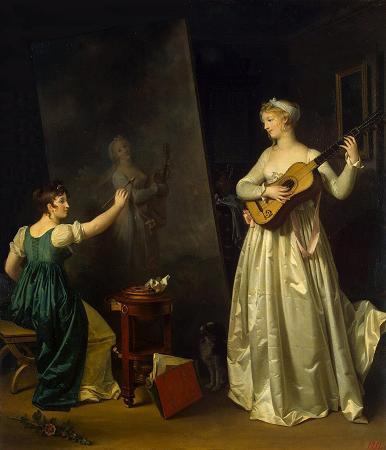Marguerite Gerard (1761 - 1837). Marguerite Gerard was a successful French painter and print-maker working in the Rococo style. She was the daughter of Marie Gilette and perfumer Claude Gerard. At eight years old she became the sister-in-law of Jean-Honore Fragonard, and when she was 14, she went to live with him. She was also the aunt of the artist Alexandre-Evariste Fragonard. Gerard became Fragonard's pupil in the mid-1770s and studied painting, drawing and printmaking under his tutelage. Gerard and Fragonard created nine etchings in 1778. Historians currently believe Gerard was the sole artist of five of these etchings since many have a duplicate created by her tutor Fragonard. More than 300 genre paintings, 80 portraits, and several miniatures have been documented to Gerard. One of her paintings, The Clemency of Napoleon, was purchased by Napoleon in 1808. Upon the death of her mother in 1775, Marguerite Gerard, the youngest of the seven children, took up residence in the Louvre with her sister and her sister's husband Jean-Honor Fragonard. She lived in the Louvre with them for approximately thirty years, allowing her to view and be inspired by great artworks of the past and present. By 1785 she had established a reputation for being a gifted genre painter, the first French woman to do so. Of particular interest to Gerard were the genre scenes of the Dutch Golden Age which she would emulate in her own work. She was denied membership to the Academie Royale de Peinture et de Sculpture due to its rules limiting the number of female artists to four at any one time. The Academy denied women the free art training offered to men at the Ecole des Beaux-Arts, or the right to compete for the prestigious Prix de Rome. Despite these obstacles, she went on to exhibit widely, particularly following the French Revolution when the Salon was opened to women. Her work was exhibited in the Salon between 1799 and 1824 and she won a Prix du 5eme classe in 1799, a Prix d'encouragement in 1801 and a Medaille d'Or in 1804. Her association with Fragonard's circle allowed Gerard the freedom to remain unmarried without becoming a financial burden to herself or her parents; this allowed her to devote her life to becoming an artist, a career she continued with considerable commercial success for more than fifty years. Speculation that Gerard and Fragonard were lovers has been thoroughly disproved, and Gerard referred to the older artist as a father figure. After the death of Fragonard she continued to live with her sister for 17 years. Gerard became interested in art while living with her sister, Marie-Anne Fragonard, and brother-in-law, Jean-Honore Fragonard, in Paris. She aspired to become an artist like her sister, a painter of miniatures, and her brother-in-law encouraged her ambitions. She began training with Fragonard at the age of 16. She became an unofficial apprentice of Jean-Honore Fragonard, working from his drawings to create her first pieces of work; soon after, she began to create her own genre paintings. The depiction of everyday life closely resembles the style of Gerard Ter Borch and Gabriel Metsu, Dutch artists from the seventeenth century. Much like these Dutch artists, Gerard painted meticulous details using finely blended brushstrokes. Her unpretentious paintings represented the major underground current in the art of the early 1800s. Depicting the minor domestic dramas in the homes of the rich middle class, Marguerite Gerard not only paved the way for other women artists, but also men of the next generation, including her nephew Alexandre Evariste, to whom she tried to be what Fragonard had been to her. As a genre artist, Geerard focused on portraying scenes of intimate domestic life. However, unlike other female painters who liked to refer to classical antiquity, Marguerite Gerard often used costumes and settings from a few centuries before her own. Domestic cats and dogs also show up repeatedly in Gerard's work. Many of her paintings illustrate the experience of motherhood and childhood within the home, and several emphasize the importance of music and female companionship. One of her more ambitious engravings, The Genius of Franklin, depicts an allegorical scene of Benjamin Franklin and America personified as a woman. This engraving's subject matter helped introduce Gerard's work to a larger audience since prints could be produced easily. Gerard also painted at least thirty-five portraits of painters, actors, and patrons between 1787 and 1791. Gerard was a well-known painter during her lifetime. LeBreton's official report of the state of French art published in 1808 claims that by 1789, Gerard's reputation matched those of Anne Vallayer-Coster, Adelaede Labille-Guiard and Elisabeth Vigee-Lebrun.
more...









